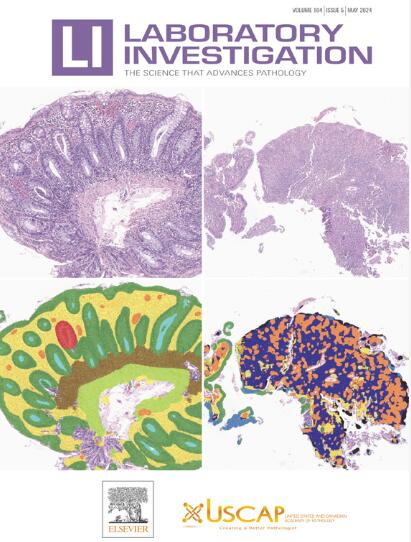机器视觉检测到的瘤周淋巴细胞聚集与甲状腺乳头状癌患者的无病生存率有关
IF 5.1
2区 医学
Q1 MEDICINE, RESEARCH & EXPERIMENTAL
引用次数: 0
摘要
甲状腺乳头状癌(PTC)是最常见的甲状腺癌,复发率约为20%。在慢性炎症、感染和免疫反应过程中,非淋巴组织中出现的淋巴样形成与肿瘤抑制有关。淋巴聚集体有可能增强机体的抗肿瘤反应,为吸引肿瘤浸润淋巴细胞(TILs)并促进其协调提供了途径。越来越多的证据表明,淋巴细胞聚集密度在控制肿瘤侵袭和转移方面发挥着重要作用,并对各种癌症类型的总生存期和无病生存期(DFS)产生了有利影响。在这项工作中,我们提出了一种机器视觉模型,利用与瘤周淋巴聚集密度相关的测量值预测不同组织学亚型 PTC 的复发情况。我们证明,量化瘤周淋巴细胞的存在不仅与更好的预后相关,而且在没有包括 TERT 在内的众所周知的二次突变的情况下,与肿瘤内的 TIL 一起增加了额外的预后价值。TCGA-THCA 数据集中 171 个分化良好的 PTC 的瘤周淋巴聚集注释被用来训练一个深度学习模型,以预测整个组织的淋巴聚集区域。对这些淋巴细胞覆盖的组织区域的面积分数进行二分,以确定两个风险组:瘤周淋巴细胞密度高和低。通过 Kaplan-Meier (KM) 分析,利用这些风险组别对 DFS 进行预后预测,结果显示危险比 (HR)=2.51 (95% 置信区间 (CI):2.36, 2.66),该结果也在 TCGA-THCA 数据集中的 170 名新患者中进行了测试。瘤周淋巴细胞聚集密度的预后效果与使用原发肿瘤内瘤周淋巴细胞的分数面积对 DFS 进行的单变量 KM 分析进行了比较,HR = 2.04 (95% CI: 1.89, 2.19)。将肿瘤内和肿瘤周围的淋巴细胞特征结合在一起,在统计学上显著提高了预后效果(HR = 3.17 (95% CI: 3.02, 3.32)),并与 TCGA-THCA 以外的 62 例患者进行了独立评估,HR = 2.44 (95% CI: 2.19, 2.69)。对验证集进行的多变量 Cox 回归分析表明,瘤周和瘤内淋巴细胞密度是独立于组织学亚型的预后指标,C 指数 = 0.815。本文章由计算机程序翻译,如有差异,请以英文原文为准。
Machine Vision–Detected Peritumoral Lymphocytic Aggregates Are Associated With Disease-Free Survival in Patients With Papillary Thyroid Carcinoma
Papillary thyroid carcinoma (PTC) is the most prevalent form of thyroid cancer, with a disease recurrence rate of around 20%. Lymphoid formations, which occur in nonlymphoid tissues during chronic inflammatory, infectious, and immune responses, have been linked with tumor suppression. Lymphoid aggregates potentially enhance the body’s antitumor response, offering an avenue for attracting tumor-infiltrating lymphocytes and fostering their coordination. Increasing evidence highlights the role of lymphoid aggregate density in managing tumor invasion and metastasis, with a favorable impact noted on overall and disease-free survival (DFS) across various cancer types. In this study, we present a machine vision model to predict recurrence in different histologic subtypes of PTC using measurements related to peritumoral lymphoid aggregate density. We demonstrated that quantifying peritumoral lymphocytic presence not only is associated with better prognosis but also, along with tumor-infiltrating lymphocytes within the tumor, adds additional prognostic value in the absence of well-known second mutations including TERT. Annotations of peritumoral lymphoid aggregates on 171 well-differentiated PTCs in the Cancer Genome Atlas Thyroid Carcinoma (TCGA-THCA) data set were used to train a deep-learning model to predict regions of lymphoid aggregates across the entire tissue. The fractional area of the tissue regions covered by these lymphocytes was dichotomized to determine the following 2 risk groups: a significant and low density of peritumoral lymphocytes. DFS prognosticated using these risk groups via the Kaplan-Meier analysis revealed a hazard ratio (HR) of 2.51 (95% CI: 2.36, 2.66), tested on 170 new patients also from the TCGA-THCA data set. The prognostic performance of peritumoral lymphocyte aggregate density was compared against the univariate Kaplan-Meier analysis of DFS using the fractional area of intratumoral lymphocytes within the primary tumor with an HR of 2.04 (95% CI: 1.89, 2.19). Combining the lymphocyte features in and around the tumor yielded a statistically significant improvement in prognostic performance (HR, 3.17 [95% CI: 3.02, 3.32]) on training and were independently evaluated against 62 patients outside TCGA-THCA with an HR of 2.44 (95% CI: 2.19, 2.69). Multivariable Cox regression analysis on the validation set revealed that the density of peritumoral and intratumoral lymphocytes was prognostic independent of histologic subtype with a concordance index of 0.815.
求助全文
通过发布文献求助,成功后即可免费获取论文全文。
去求助
来源期刊

Laboratory Investigation
医学-病理学
CiteScore
8.30
自引率
0.00%
发文量
125
审稿时长
2 months
期刊介绍:
Laboratory Investigation is an international journal owned by the United States and Canadian Academy of Pathology. Laboratory Investigation offers prompt publication of high-quality original research in all biomedical disciplines relating to the understanding of human disease and the application of new methods to the diagnosis of disease. Both human and experimental studies are welcome.
 求助内容:
求助内容: 应助结果提醒方式:
应助结果提醒方式:


